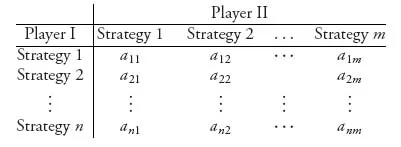
- English
- ePUB (mobile friendly)
- Available on iOS & Android
About this book
An exciting new edition of the popular introduction to game theory and its applications
The thoroughly expanded Second Edition presents a unique, hands-on approach to game theory. While most books on the subject are too abstract or too basic for mathematicians, Game Theory: An Introduction, Second Edition offers a blend of theory and applications, allowing readers to use theory and software to create and analyze real-world decision-making models.
With a rigorous, yet accessible, treatment of mathematics, the book focuses on results that can be used to determine optimal game strategies. Game Theory: An Introduction, Second Edition demonstrates how to use modern software, such as Maple™, Mathematica®, and Gambit, to create, analyze, and implement effective decision-making models. Coverage includes the main aspects of game theory including the fundamentals of two-person zero-sum games, cooperative games, and population games as well as a large number of examples from various fields, such as economics, transportation, warfare, asset distribution, political science, and biology. The Second Edition features: • A new chapter on extensive games, which greatly expands the implementation of available models • New sections on correlated equilibria and exact formulas for three-player cooperative games • Many updated topics including threats in bargaining games and evolutionary stable strategies • Solutions and methods used to solve all odd-numbered problems • A companion website containing the related Maple and Mathematica data sets and code
A trusted and proven guide for students of mathematics and economics, Game Theory: An Introduction, Second Edition is also an excellent resource for researchers and practitioners in economics, finance, engineering, operations research, statistics, and computer science.
Frequently asked questions
- Essential is ideal for learners and professionals who enjoy exploring a wide range of subjects. Access the Essential Library with 800,000+ trusted titles and best-sellers across business, personal growth, and the humanities. Includes unlimited reading time and Standard Read Aloud voice.
- Complete: Perfect for advanced learners and researchers needing full, unrestricted access. Unlock 1.4M+ books across hundreds of subjects, including academic and specialized titles. The Complete Plan also includes advanced features like Premium Read Aloud and Research Assistant.
Please note we cannot support devices running on iOS 13 and Android 7 or earlier. Learn more about using the app.
Information

Table of contents
- Cover
- Wiley Series in Operations Research and Management Science
- Title Page
- Copyright
- Dedication
- Preface for the Second Edition
- Preface for the First Edition
- Acknowledgments
- Introduction
- Chapter One: Matrix Two-Person Games
- Chapter Two: Solution Methods for Matrix Games
- Chapter Three: Two-Person Nonzero Sum Games
- Chapter Four: Games in Extensive Form: Sequential Decision Making
- Chapter Five: N-Person Nonzero Sum Games and Games with a Continuum of Strategies
- Chapter Six: Cooperative Games
- Chapter Seven: Evolutionary Stable Strategies and Population Games
- Appendix A: The Essentials of Matrix Analysis
- Appendix B: The Essentials of Probability
- Appendix C: The Essentials of Maple
- Appendix D: The Mathematica Commands
- Appendix E: Biographies
- Problem Solutions
- References
- Index